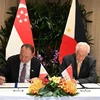Singapore (VNA) - The emergence of the Omicron COVID-19 variant could impact the recovery of trade in goods and services in ASEAN economies, said Sithanonxay Suvannaphakdy, researcher at the ISEAS–Yusof Ishak Institute of Singapore.
In his article posted on Fulcrum.sg on December 13, he said even before Omicron’s appearance on the scene, there were already downside risks of economic recovery. These included supply chain disruptions — longer port delays, higher shipping costs, shortages of semiconductors — rising consumer prices and the ongoing outbreak of Covid-19 in ASEAN economies and their key trading partners. The outbreak of the Omicron variant could further reduce demand for goods and services from within and outside the region in 2022.
According to him, the Omicron variant could reduce intra- and extra-ASEAN trade in goods and services, at least in the short term, due to greater international travel restrictions and more frequent lockdowns, he said, adding higher travel restrictions impact trade flows by making it hard for business partners in different countries to meet in person to transact deals. In-person meetings remain essential to facilitate trade, although a large proportion of the labour force has managed to transition to working from home and firms continue to maintain business relationships.
As of December 1, seven out of 10 ASEAN countries, namely Singapore, Malaysia, Indonesia, Myanmar, the Philippines, Thailand and Vietnam, have already tightened their entry and quarantine rules due to concerns over the Omicron variant. ASEAN’s key trading partners such as Japan, India and the Republic of Korea have also tightened their border controls. Although ASEAN countries and their trading partners have allowed business travel to resume, international travel costs, which include airfare, quarantine and testing requirements, are high. Micro and small enterprises, which engage in relatively smaller amounts of cross-border trade, may not be able to bear such costs.
In addition, the highly infectious COVID-19 variants such as Delta and Omicron increase the risk of more frequent lockdowns even if one or a handful of new cases are detected in ASEAN and its key trading partners. For example, China has implemented a zero-COVID strategy, which involves massive lockdowns, tight border controls, contact tracing and quarantine. Although the country has not yet introduced tougher measures on international travel, it has already imposed extremely tight travel restrictions.
China is ASEAN’s biggest trading partner. More frequent lockdowns in China can reduce household consumption of imported goods, including those from ASEAN economies. In 2020, household consumption in China accounted for 37.7 percent of GDP. An analysis of International Trade Centre trade data in 2020 reveals that China was the top-ranked export destination for Indonesia, Malaysia, Myanmar and Singapore, while it was the second-ranked export destination for Laos, Thailand and Vietnam. The remaining ASEAN economies, namely Brunei, Cambodia and the Philippines, listed China as their third-largest export destinations. ASEAN’s heavy reliance on the Chinese market suggests that a small reduction in Chinese demand for goods from ASEAN can lead to a substantial reduction in ASEAN’s exports.
Sithanonxay Suvannaphakdy concluded that the Omicron variant would not only lead to greater international travel restrictions, but also increase the risk of more frequent lockdowns in ASEAN and its key trading partners. The actual trade effects will depend on the ability of firms to adapt to the digital trade era, sustain business relationships without in-person meetings, and substitute foreign suppliers with domestic ones./.

Indonesian minister calls for AI use to strengthen ASEAN cooperation
Coordinating Minister for Economic Affairs of Indonesia AirlanggaHartarto has emphasized the importance of cooperation in the development of Artificial Intelligence (AI) technology to improve and strengthen ASEAN cooperation.

























